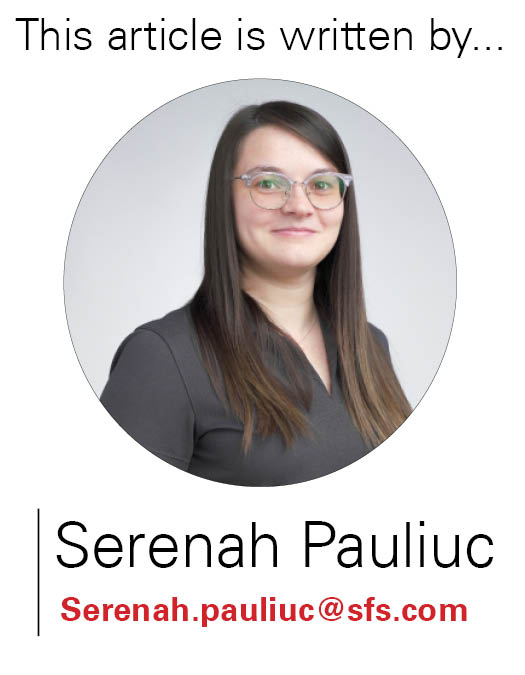How 3D printing technology enables innovation in construction
3D printing has been a buzz-worthy technology for the past decade. Initially conceived for product prototyping, 3D printing has become a mainstay in various industries. Today, 3D printing is poised to shake up the construction industry with a multitude of applications for all kinds of projects, including those from SFS.
How is 3D printing leveraged in construction?
There are various ways to implement 3D printing technology in construction projects. Two notable applications include prototyping and concrete construction.Prototyping
Fastener samples can be developed quickly with 3D printing extrusion technology. Prototyping in this manner makes it easier to analyze and adjust different options rapidly. 3D printing also makes small-scale development much more feasible and affordable — you can print out a single object to determine if your design will work, instead of having to order dozens.
Concrete construction
Concrete extrusion technology can be leveraged to construct walls or entire buildings. Instead of transporting entire walls, a build team can transport the raw materials (typically just the dry component) used to create concrete. Then, risks are reduced during the construction phase since technology can be leveraged instead of human effort.
Why would 3D printing be leveraged in construction?
The construction industry often clashes with tight deadlines and budgets. The speed and affordability of 3D printing make it a valuable option for all types of projects.Waste is another common concern in construction projects. 3D printing is a unique strategy for development that minimizes waste, by limiting material inputs to only those required.
Initially developed for innovation, 3D printing unlocks insurmountable opportunities to inject creativity into commercial construction projects.
What are the benefits of leveraging 3D printing in construction?
There are many benefits of using 3D printing in various stages of construction. The top three include speed, waste reduction, and increased innovation.Speed
One of the key challenges in construction projects is staying on time. 3D printing can reduce that barrier as this technology is known for its speed and efficiency. By leveraging 3D printing, teams can complete projects quickly and safely.
Reduced waste
3D printing uses the exact amount of material required, minimizing excess waste. There’s no need to shave off extra materials in the end. Additionally, with 3D printing, hollow spaces can be left where material isn’t required, reducing the overall input need.
Further, with 3D printing technology, construction teams can leverage materials locally available for development, minimizing emissions from shipping components and the dangers of toxic materials on-site.
3D printing also provides the opportunity to repair tools that would otherwise be destined for the landfill. When manufacturers don’t offer replacement parts, if one piece breaks, then you must replace the entire tool. With 3D printing, you can reverse engineer the part to be replaced, and print a new one quickly.
Innovation
With 3D printing, architects and engineers are afforded a unique level of design flexibility, not offered anywhere else. Complex designs that would otherwise be impossible to develop are made possible through 3D printing technology.
What 3D printing technologies and applications does SFS leverage?
At SFS we pride ourselves on staying on the cutting edge of new technologies and innovation. We presently leverage 3D printing in a few ways in order to better serve our customers needs:- Tool repair and replacement parts — 3D printed parts provide the same performance as their metal counterparts, but reduce tool weight and customer price
- Prototyping new innovative designs — 3D printing speeds up the prototyping process while enabling enhanced innovation.
- Waste reduction in the innovation process — by 3D printing prototypes instead of casting in metal, we can minimize wasted materials.
- Replacement of otherwise obsolete parts — when manufacturers no longer offer specific parts, we can 3D print replacements.
- Reduce customer wait times — our fast 3D printing prototyping for customer-specific parts and innovation can significantly speed up the time to value.
What’s an example of SFS’s 3D printing technology in action?
Check out some of our 3D printing technology in action!
Our Printers
These are the 3D printers we use for prototyping and part construction.
 Prototyping and innovation
Prototyping and innovationAnother way we use 3D printing is for prototyping and innovation. Before sending a new beveled washer design to be manufactured out of metal, 3D printing was used to determine if the part had optimal dimensions for the application.
 3D printing for the isoweld systems
3D printing for the isoweld systemsWe often use our 3D printing technology to create calibration templates for the Isoweld backpack® system. This helps us ensure the Isoweld system is as accurate as possible.
 Reverse engineering
Reverse engineeringWhen a part breaks that a manufacturer doesn’t offer replacements of, we can reverse engineer the piece. This was from a paper printer, which had a broken plastic part. We were able to reverse-engineer the piece and print a replacement part to get the printer functioning again. Even better, it was faster than it would have been to order a part from the manufacturer, even if they were available.
Why SFS is leveraging 3D printing to stay at the forefront of innovation
3D printing represents significant opportunities in the construction industry, across the board. By enabling reduced costs, quicker production times, waste minimization, and enhanced innovation opportunities, 3D printing is an invaluable technology, no matter what type of construction work you do.Our 3D printing efforts are just one way SFS remains at the forefront of innovation and sustainability. Discover all the technologies we use to bring value to our clients.


 English (Canada)
English (Canada)
 čeština (Česká republika)
čeština (Česká republika)
 magyar (Magyarország)
magyar (Magyarország)
 Deutsch (Deutschland)
Deutsch (Deutschland)
 eesti (Eesti)
eesti (Eesti)
 español (España)
español (España)
 português (Portugal)
português (Portugal)
 suomi (Suomi)
suomi (Suomi)
 français (France)
français (France)
 English (United Kingdom)
English (United Kingdom)
 italiano (Italia)
italiano (Italia)
 Nederlands (Nederland)
Nederlands (Nederland)
 norsk, bokmål (Norge)
norsk, bokmål (Norge)
 polski (Polska)
polski (Polska)
 svenska (Sverige)
svenska (Sverige)
 Türkçe (Türkiye)
Türkçe (Türkiye)

